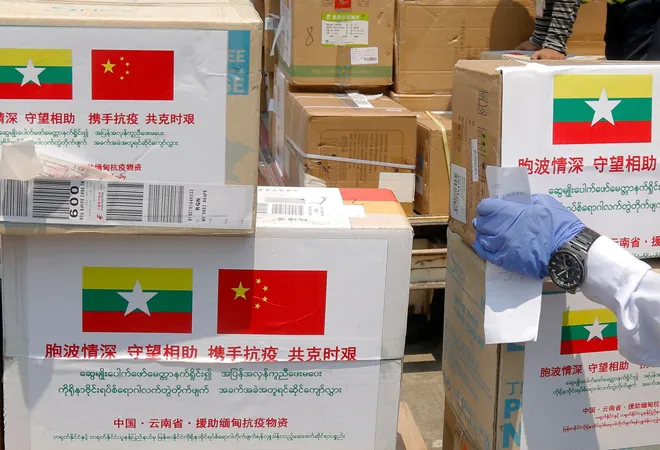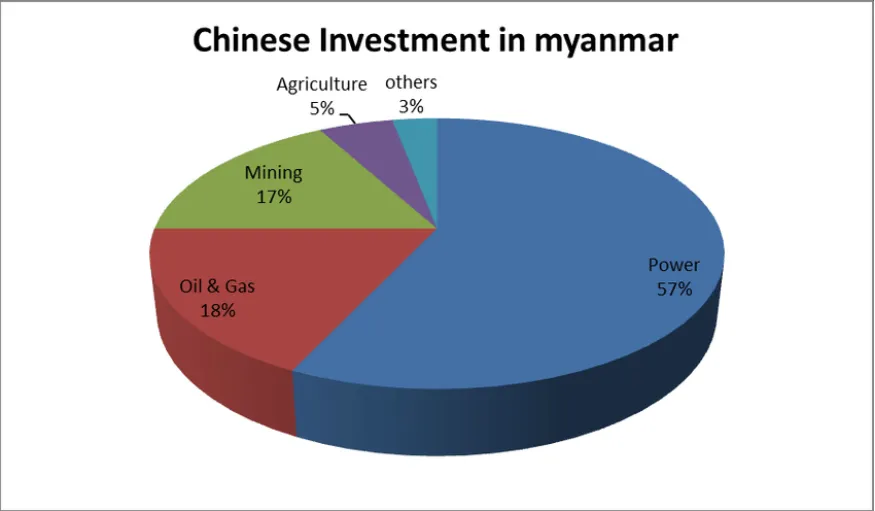
Myanmar-China relations have often been described as ‘
Pauk Phaw’—a fraternal relationship—owing to its political, economic, and diplomatic ties. The two countries share a 2129-km-long border and have deep historical and cultural ties. The relationship underwent a transformation post-1988 as the Western nations sanctioned Naypyidaw for human rights abuse and political instability due to the coup. It was during this time that Beijing became the largest trading partner of the Southeast Asian neighbour and to this date continues to be so.
While the dynamic relations between the two have witnessed several
ups and downs in the past owing to the wariness of Myanmar authorities towards Chinese intent—be it weaponising ethnic groups, debt scares, or, unsustainable projects—the relationship has always maintained its strong course despite all odds. One significant factor in this is the steady economic ties that have grown in importance over the past two decades.
In recent years, China has become one of Myanmar's largest trading partners. According to the Ministry of Commerce, Myanmar, the bilateral trade between
April 2022 and half of January 2023 in the financial year 2022-2023, reached up to US$2159.412 million.
 Source: Ministry of Commerce, SAC
Source: Ministry of Commerce, SAC
Myanmar conducts cross-border trade with China through border posts situated in Muse, Lweje, Chinshwehaw, Kampaiti, and The other border points namely the Lweje border . While the other two border points the Kampaiti border earned trade
Significant partner
. . Additionally, has helped expand the economic scope within Myanmar. The Greater Mekong Subregion Economic Cooperation comprising China, Lao PDR, Cambodia, Thailand, Vietnam, and Myanmar also, presented a forum to pool in each other’s strengths and fortify cooperation in trade and investment.
Since Myanmar opened its door to foreign investment in 1988, the approved Chinese investment amounted to
26 percent of total FDI in Myanmar till 2019. China has been investing consistently in physical infrastructure projects under the Belt and Road Initiative (BRI) through China-Myanmar Economic Corridor (CMEC). Several projects under the CMEC, for instance, the Mee Ling Gyaing LNG terminal, Kyaukphyu SEZ, deep seaport, upgrading of the Mandalay-Muse Road that will facilitate the Muse-Mandalay railway line are examples of Chinese economic interest within the nation.
China has been investing consistently in physical infrastructure projects under the Belt and Road Initiative (BRI) through China-Myanmar Economic Corridor (CMEC).
Myanmar's exports to China are primarily agricultural products, such as rice, beans, and sesame seeds.
In 2019, agricultural exports accounted for 83 percent of Myanmar's total exports to China. Myanmar is also exporting more minerals, such as jade and copper, to China. In contrast, China's exports to Myanmar are primarily manufactured goods, such as machinery, electronics, and textiles.
The growing trade relationship between Myanmar and China has been driven by several factors. First, China's demand for Myanmar's natural resources has increased as its economy has grown. Myanmar is rich in natural resources such as oil, gas, timber, and minerals, and China has invested heavily in these sectors. Myanmar exports of pearls, precious stones, metals, and coins to China were
US$12.31 million in 2021.
 Source: The Irrawaddy
Source: The Irrawaddy
Second, China's Belt and Road Initiative (BRI) has played a significant role in increasing trade and investment between the two countries. Myanmar is a key part of the BRI, with several infrastructure projects underway, including the China-Myanmar Economic Corridor (CMEC). The
CMEC includes a deep-sea port at Kyaukphyu, an industrial park, and a high-speed rail link between Kunming in China and Mandalay in Myanmar. Many of these projects are stated to be on track even post-coup.
Apart from connectivity routes, Chinese companies are now implementing many resource-sharing links whereby power projects including hydropower plants are being constructed in several locations. In October 2022, the
US$180-million,135-MW power plant in the Kyaukphyu Special Economic Zone (SEZ) was inaugurated.
Challenges
However, the trade relationship between Myanmar and China has not been without its challenges. One of the most significant challenges is the issue of trade imbalance. Myanmar has been running a large trade deficit with China for several years. Between 2022-2023 till mid- This trade imbalance is a concern for Myanmar, as it can make the country dependent on China for its imports and vulnerable to economic pressure.
Another challenge is the perception of the activists and the majority of the population in Myanmar that Chinese companies are exploiting the country's natural resources without providing significant benefits to the local population. , which was suspended in 2011 due to public opposition. There in the past.
China has been criticised over the sustainability of its loans to developing countries, as well as its poor record in terms of generating occupations and adhering to ecological standards.
The
debt scare aspect has been another element that economists have been wary about. China’s development model as observed in other nations often encompasses state-led infrastructure projects for which natural resources are required as a warranty. China has been criticised over the sustainability of its loans to developing countries, as well as its poor record in terms of generating occupations and adhering to ecological standards. There have been successive claims by different scholars that much of the Chinese lending to other countries is “hidden”. Prominent organisations like the
International Monetary Fund (IMF) or the World Bank, are serious concerns over transparency.
Post-coup, the conditions have deteriorated as the general public is indignant with the Chinese actions of continuing business as usual with the military regime as well as shielding it from international spectators. This has led to growing aggression over Chinese-led businesses for instance the
vandalising of Chinese companies during 2021-2022.
It may be important to recall that Myanmar is not ignorant of the Chinese advances and has been careful in its earlier stances to balance Chinese trails within the region either by ruling against the projects like the Myitsone dam, negotiating proper deals, for instance, the cost of Kyaukphyu project was
reduced by almost 80 percent and Myanmar’s share in the project was increased from 15 to 30 percent. It has also partnered with other players in the region like Japan and India.
However, the present coup creates more uncertainty in terms of the continuous people’s and ethnic armed group movements against the regime. Thus, the present regime in Myanmar will need to keep its balancing act intact as it opens its business with other partners and pursues its ambition to stay afloat amidst the harsh waters of protests.
The views expressed above belong to the author(s). ORF research and analyses now available on Telegram! Click here to access our curated content — blogs, longforms and interviews.



 Myanmar-China relations have often been described as ‘Pauk Phaw’—a fraternal relationship—owing to its political, economic, and diplomatic ties. The two countries share a 2129-km-long border and have deep historical and cultural ties. The relationship underwent a transformation post-1988 as the Western nations sanctioned Naypyidaw for human rights abuse and political instability due to the coup. It was during this time that Beijing became the largest trading partner of the Southeast Asian neighbour and to this date continues to be so.
While the dynamic relations between the two have witnessed several
Myanmar-China relations have often been described as ‘Pauk Phaw’—a fraternal relationship—owing to its political, economic, and diplomatic ties. The two countries share a 2129-km-long border and have deep historical and cultural ties. The relationship underwent a transformation post-1988 as the Western nations sanctioned Naypyidaw for human rights abuse and political instability due to the coup. It was during this time that Beijing became the largest trading partner of the Southeast Asian neighbour and to this date continues to be so.
While the dynamic relations between the two have witnessed several 

 PREV
PREV


